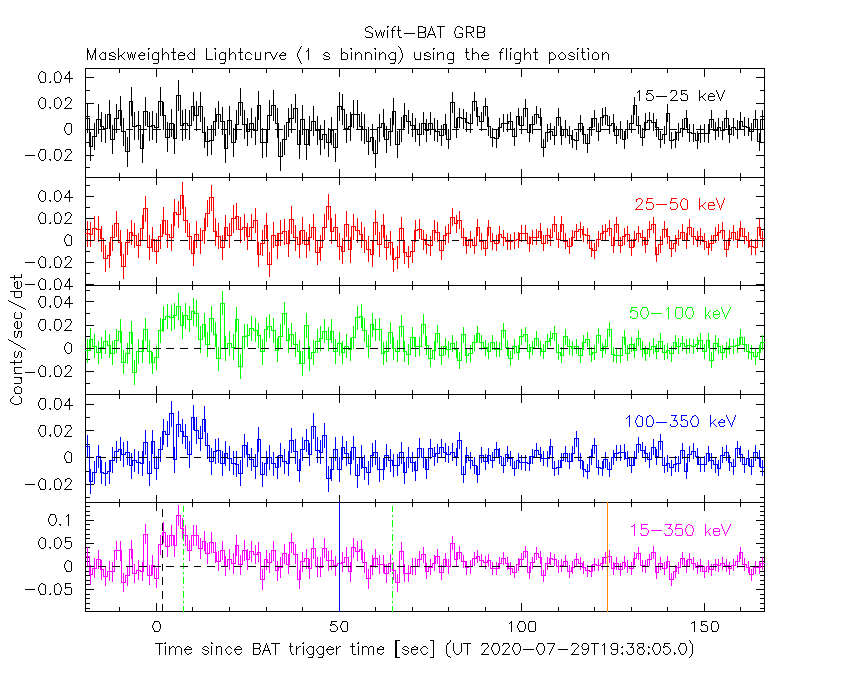
P.A. Evans (U. Leicester), A. Tohuvavohu (U. Toronto) and S.R. Oates (U.Birmingham) for the Swift team
At 19:38:05 UT, the Swift Burst Alert Telescope (BAT) triggered and located GRB 200729A (trigger=984929) (Evans et al. GCN Circ. 28165). Swift slewed immediately to the burst. At the time of the trigger, the initial BAT position was 53° from the Sun (3.7 hours East) and 85° from the 75%-illuminated Moon. Table 1 contains the best reported positions from Swift, and the latest XRT position can be viewed at http://www.swift.ac.uk/xrt_positions.
Table 2 is a summary of GCN Circulars about this GRB from observatories other than Swift.
Standard analysis products for this burst are available at https://gcn.gsfc.nasa.gov/swift_gnd_ana.html.
As reported by Krimm et al. (GCN Circ. 28179),
the BAT ground-calculated position is RA, Dec = 184.360, 45.571 deg which is RA(J2000) = 1
The mask-weighted light curve (Figure 1) shows a weak pulse that starts at ~
The time-averaged spectrum from T+0.54 to T+136.54 s is best fit by a simple power-law model.
The power law index of the time-averaged spectrum is 0.96 ± 0.27.
The fluence in the 15-150 keV band is 1.6 ± 0.2 x 1
The results of the batgrbproduct analysis are available at https://gcn.gsfc.nasa.gov/notices_s/984929/BA/.
Analysis of the initial XRT data was reported by Tohuvavohu et al. (GCN Circ. 28176). We have analysed 26 ks of XRT data for GRB 200729A, from 144 s to 609.2 ks after the BAT trigger. The data comprise 213 s in Windowed Timing (WT) mode with the remainder in Photon Counting (PC) mode. The enhanced XRT position for this burst was given by Osborne et al. (GCN Circ. 28168).
The light curve (Figure 2) can be modelled with a power-law decay with a decay index of α=1.44 ± 0.04.
A spectrum formed from the WT mode data can be fitted with an absorbed power-law with a photon spectral index of 1.78 ± 0.13. The best-fitting absorption column is 7.9 (+1.2, -1.1) x 1
A summary of the PC-mode spectrum is thus:
Total column: 9.6 (+2.9, -2.5) x 1
Galactic foreground: 1.1 x 1
Excess significance: 6.4 σ
Photon index: 1.38 (+0.22, -0.21)
The results of the XRT team automatic analysis are available at http://www.swift.ac.uk/xrt_products/00984929.
The Swift/UVOT began settled observations of the field of GRB 200729A 145 s after the BAT trigger
(Oates and Evans GCN Circ. 28177).
No optical afterglow is detected above the flux of NGC 4242, consistent with the XRT position (Osborne et al. GCN Circ. 28168), in the initial UVOT exposures.
Table 3 gives preliminary
magnitudes using the UVOT photometric system
(Breeveld et al. 2011, AIP Conf. Proc., 1358, 373).
No correction has been made for the expected extinction in the Milky Way
corresponding to a reddening of

Figure 1. The BAT
mask-weighted light curve in the four individual and total
energy bands. The units are counts

Figure 2. The XRT light curve.
Any data from a crosshatched region are not included in the fit.
| RA (J2000) | Dec (J2000) | Error | Note | Reference |
|---|---|---|---|---|
| 1 |
+45°35'41.2" | 1.4" | XRT-final | UKSSDC |
| 1 |
+45°35'41.1" | 1.7" | XRT-enhanced | Osborne et al. GCN Circ. 28168 |
| 1 |
+45°34'13.9" | 2.3' | BAT-refined | Krimm et al. GCN Circ. 28179 |
| Band | Authors | GCN Circ. | Subject | Observatory | Notes |
|---|---|---|---|---|---|
| Optical | Lipunov et al. | 28166 | Swift GRB 200729A: Global MASTER-Net observations report |
MASTER | |
| Optical | Hu et al. | 28167 | BOOTES-1 optical upper limit | BOOTES-1 | upper limits |
| Optical | Malesani et al. | 28169 | NOT optical upper limits | NOT | upper limits |
| Optical | D'Avanzo et al. | 28170 | TNG NIR upper limits | TNG | upper limits |
| Optical | Kilpatrick et al. | 28172 | Pan-STARRS pre-explosion source detection |
Pan-STARRS | detection |
| Optical | Anand et al. | 28175 | HST imaging | HST | |
| Optical | Malesani et al. | 28178 | further analysis of the NOT data | NOT | |
| Optical | Zhu et al. | 28180 | Nanshan/NEXT optical upper limit | Xinjiang Astro. Obs. | upper limits |
| Radio | Hajela et al. | 28181 | VLA Observations | VLA | |
| Radio | Volvach et al. | 28182 | RT-22 observations at 36.8 GHz | CrAO RT-22 | |
| Gamma-ray | Malacaria et al. | 28174 | Fermi-GBM Sub-Threshold candidate for GRB 200729A |
Fermi GBM | |
| Gamma-ray | Ridnaia et al. | 28192 | Konus-Wind detection | Konus-Wind | Fluence=5.23(-1.00,+1.32)x1 |
| Neutrino | Collaboration | 28173 | IceCube neutrino search | IceCube | |
| Other | Laskar et al. | 28171 | Spitzer archival source detection | detection | |
| Other | Dichiara et al. | 28270 | Lowell Discovery Telescope observations |
| Filter | Exp(s) | Mag | ||
|---|---|---|---|---|
| whit |
145 | 295 | 147 | >20.0 |
| 303 | 553 | 246 | >18.9 | |
| white | 145 | 1874 | 431 | >20.0 |
| v | 633 | 1749 | 136 | >17.6 |
| b | 559 | 1849 | 136 | >18.7 |
| u | 303 | 1824 | 362 | >18.9 |
| w1 | 682 | 1799 | 97 | >18.2 |
| m2 | 658 | 1428 | 39 | >17.8 |
| w2 | 1359 | 1725 | 58 | >17.8 |
Table 3. UVOT observations reported by Oates and Evans (GCN Circ. 28177). The start and stop times of the exposures are given in seconds since the BAT trigger. The preliminary 3-σ upper limits are given. No correction has been made for extinction in the Milky Way.
August 20, 2020